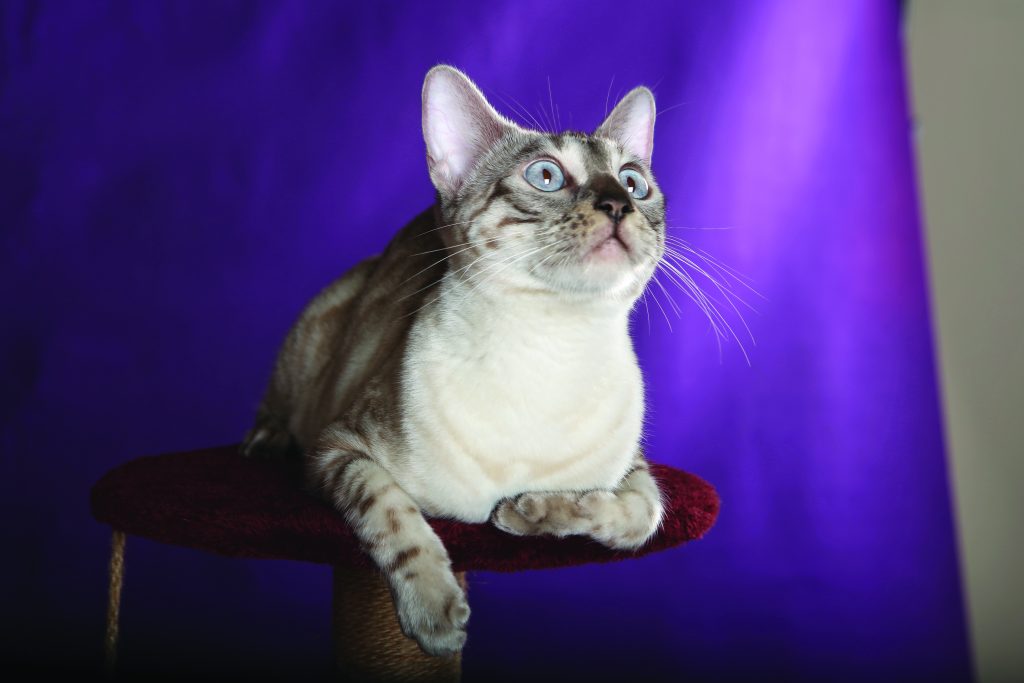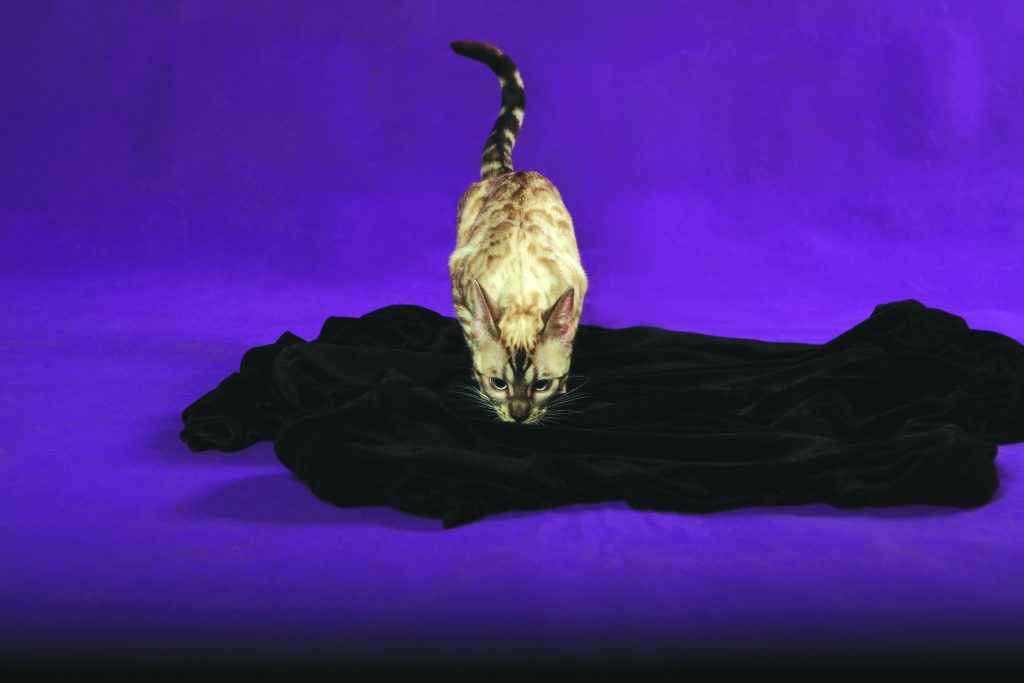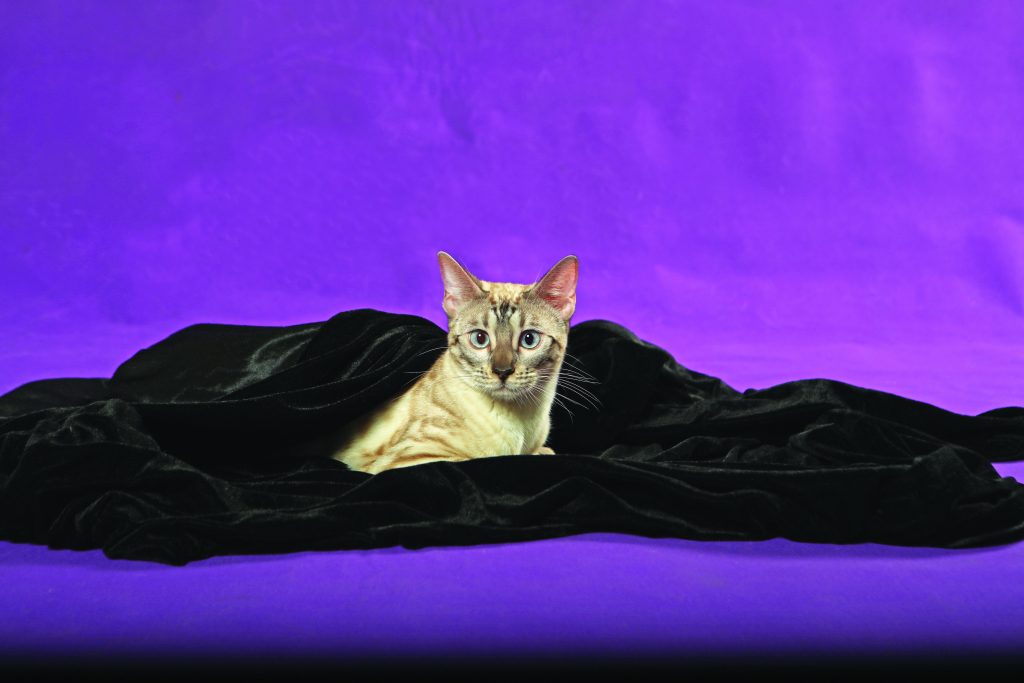What with their exotic coat patterns and relatively large size, it’s no wonder people are instantly drawn to the Bengal cat’s wild appearance. Outside of their physical looks, it is their tame and playful personality that make them as charming as any other domesticated feline.
Bengal cats got their name from the Asian Leopard cat’s taxonomic name Prionailurus Bengalensis, and aptly so, as they resemble their wild cat ancestors’ distinct coat patterns and striking features. They are a medium- to large-sized cat with a muscular and sturdy build. According to BengalCatWorld.com, male Bengals weigh between 4.5 to 6.8 kilograms on average and females between 3.6 to 5.4 kilograms.
Bengals are domesticated in every aspect, but the beautiful markings and fierce features they have resembling that of a jungle cat make us feel lucky to have them invite us over for a walk over to their wild side!
Quick Bengal facts
1. Many Bengals love to play with water. They will drink straight out of the tap or watch their human companions take a bath!
2. Their coats have hairs with tips that sparkle. This makes it look as if their fur is glittered.
3. The distinctive rosettes like the markings on leopards, jaguars, and ocelots cannot be seen on any other domestic cat breed but the Bengal. Talk about unique!
More than a silver lining
We sat down with Christine Cua, human companion to ten-month old silver-snow Bengal, Sari, to find out more about what makes this breed so enchanting.

Like many cat enthusiasts, Christine got into caring for Bengals primarily as a hobby. She recalls, “At first kasi, bumili kami ng Bengal locally. So ayun parang gusto mo lang ng Bengal, hindi ka nag-research. (Well, at first, we bought a Bengal locally. So it’s just like you wanted one and didn’t do any prior research.)”
After having their first Bengal in 2017, her passion in taking care of them grew, eventually leading her into joining cat shows. That was when she started paying attention to the more detailed characteristics of the breed. “So that time, yun na yung naging mapili ka na (that is when you start to become more meticulous),” she says, referring to how she chooses a Bengal cat based on build, bone structure, chin, eyes, fur, making sure these are up to the set standards of the breed before adopting them. Currently, Christine has 11 Bengals in her care.
The most noticeable physical feature of the Bengal is their coat. Their fur comes in different colors accentuated by distinct patterns that could either be rosetted (spotted) or marbled. According to The International Cat Association (TICA), brown or black is the most common fur color ranging from gray to shades of golden, bronze, copper, or mahogany, with patterns ranging from rich browns to deep blacks. They also come in snow colors which appear as ivory, cream, or light tan, with patterns ranging from light to dark brown. Silver Bengals, on the other hand, have gray to almost white coats with dark gray to black patterns.
When asked why she chose a silver-snow Bengal, Christine says, “[Para lang may] variety lang ng color. Parang common na kasi yung gold so gusto namin i-complete lahat ng colors. (It’s just for color variety. The gold is already very common, and we wanted to complete all the colors.)”
Did you know?
Bengals are often compared to dogs because of their high IQ levels. They can be taught to stay, heel, sit, and even play fetch!
Beyond their physical appearance, Bengals are well-known for their vigorous personality. They have a side to them that is highly inquisitive and energetic, yet they can also be sweet and affectionate when they want to.
“Very playful nga, active and sweet,” Christine attests. They are also known to be chatty, seemingly having the need to constantly communicate. WildCatSanctuary.org reports that Bengals are “usually much more active and talkative than the typical domestic house cat.” Think of them as therapists, but cuter!

Having a cat with such a rambunctious character, one would wonder if there are any challenges in taking care of them. With her years of experience living with Bengals, Christine answers, “Wala eh, kasi very easy. Basta ma-provide mo lang yung food, exercise, okay na sila (There’s none, it’s very easy [to take care of them]. As long as you provide them with food, exercise, they’ll be fine). Very independent.”
However, despite their independent nature, Christine shares that since Bengals are not genetically far removed yet from their wild cat relative, the Asian leopard cat, they still exhibit wild instincts as manifested in their intense marking behavior and hunting drive – traits which some people might find challenging to deal with.
Puspins: Exotic cats in their own right
As not all cat aficionados can take care of a Bengal cat, may it be due to a busy lifestyle, lack of house space, or lack of access, one should consider adopting many of our native shorthaired cats whose striped or spotted coats also give them a very exotic look.
Not only will you help these kitties find a forever home by adopting them, but you’ll also help control the population of stray cats in your neighborhood!
Adopt with care
Equipping oneself with ample knowledge about how to care for Bengals should help future human companions approach the breed’s more unique characteristics. Sadly, many first-time rescuers and adopters overlook having proper understanding of a specific breed before bringing them home.
While some take on the challenges of caring for a cat (especially ones that need extra attention) and eventually succeed, some fail to even try.
Christine expresses her concern over people who adopt Bengals on impulse, only for them to give up caring for them as soon as they experience difficulties interacting with the breed.
As a parting advice, when we asked Christine what one should expect before adopting or rescuing a Bengal, she says, “Ang sinasabi namin, important yung research. Like, pano muna yung proper care, pano mo alagaan. (We often say research is important. Like, how do you give them proper care first, how are you going to take care of them.)”
She reiterates, “So research yung pinaka-importante. Like, ready ba sila kung ano yung kailangan (So research is most important. Like are they ready to provide what [the cats] need).”
For those who dare walk into the wonderful world of Bengals, with the breed’s captivating qualities ranging from the mild to the wild, any human companion would surely be in for an exciting time.
Breed information
Size – “Usually mga ano yan eh six kilos max na yun. Malaki na yun. Etong amin, 3.75 kilos na female. (They usually weigh up to a maximum of 6 kilos. That’s already considered big. Ours is a 3.75-kilo female.)”

Personality – Malambing, talagang grabe (They are very affectionate). Sila, they don’t know space. As in kapag natutulog ka, pepwesto sila on top, tapos diyan na matutulog sayo. (Even when you’re already asleep, they’ll lay on top of you and take a nap right there.)”
Grooming needs – “Brush and clip the nails lang. Taking a bath once a month. Yun naman yung advantage nila over dogs. Parang iwan mo lang sila, okay sila. (That’s their advantage over dogs. You can leave them alone and they’ll be fine.)”
Diet and health – “Quality cat food. Yung mga high-end na mga cat food, may meat talaga siya, so may dehydrated meat, may veggies. Twice a day sila kumakain. And problem mo pa pala pag hindi okay yung quality ng cat food, prone magkasakit. Like UTI, kidney [diseases]… So yun lang yung care. Quality food. (High-end cat food has real dehydrated meat and veggies. They eat twice a day. The problem that you could encounter if you don’t give them quality food is that they would be prone to illnesses. Like UTI, kidney [disease]… So that’s just it for care: [give them] quality food.)”
Special care – “Vitamins lang. Quality food, nutrition. Make sure lang na may time siya i-play, may space, kasi exercise. Parang everyday at least may time ka for 10 to 15 minutes playtime para ma-exercise, or else tataba. Tapos magkakasakit na. (Make sure you have time to play with them, [give them] enough space for exercise. Give them at least 10 to 15 minutes of play time every day, or else they’ll gain weight, which may lead to illness.)”
Identifying a Bengal
Based on Bengal Breed Standard, Cat Fanciers Association
HEAD: Broad, modified wedge with rounded contours, longer than wide, with high cheekbones. Slightly small in proportion to body. Top of skull flows back into the neck, with visible back skull.
PROFILE: Gently curved forehead to nose bridge. Nose may have a slight concave curve.
NOSE: Large and wide, slightly puffed nose leather. Bridge of nose extends above the eyes.

CHIN: Strong, substantial, aligns with tip of nose in profile.
MUZZLE: Full and broad, with prominent whisker pads.
EARS: Medium to small, with a wide base. Set far apart, following the contours of the face in frontal view, slight tilt forward in profile view.
EYES: Shape is round to oval. Set wide apart, with a slight bias toward the base of ear, when oval in shape. NECK: Thick and muscular, long in proportion to the body.
BODY: Long and substantial, muscular, particularly the males. Hindquarters slightly higher than shoulders.
BONE: Substantial, never delicate.
LEGS: Medium long, slightly longer rear legs. Muscular.
PAWS: Large and round, with prominent knuckles.
TAIL: Thick, tapered at the end with rounded tip. Medium in length, in proportion to body.
COAT: With qualities unique to the breed, the Bengal coat is short, close lying, soft, silky, luxurious, and ideally glittered. Allowance for slightly longer coat in kittens.
By Jurica Buenviaje
Photos by Jeffrey C. Lim
This appeared in Animal Scene magazine’s June 2019 issue.
Related stories:
– Cats mirror their owners’ personalities, new research shows
– Cats can recognize their names, but choose to ignore owners, study shows
– Life with 15 cats: Managing a multi-cat household





